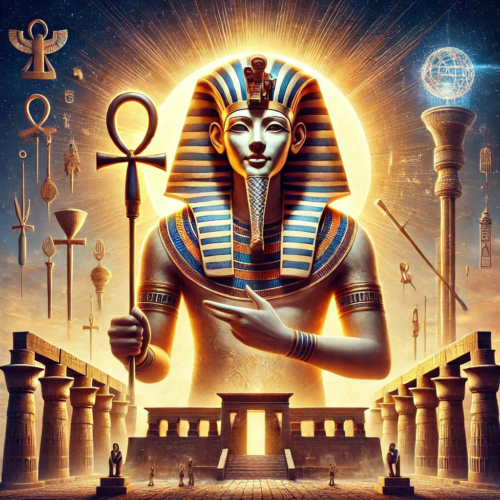Ptah is the ancient Egyptian god of creation, craftsmanship, and architecture. He is often portrayed as a figure wrapped in a tight shroud, symbolizing focus and determination, with a shaved head and a pharaoh’s beard. As the god of artisans, builders, and makers, Ptah played a vital role in Egyptian culture, inspiring creativity and innovation in those who worked with their hands.
Origins and Attributes
Ptah’s name means “opener” or “sculptor,” reflecting his role in shaping the world and giving form to creation. According to Egyptian beliefs, Ptah brought the universe into existence through the sheer power of his words. He spoke, and the world emerged—a testament to the profound influence of language and thought in Egyptian cosmology. His primary symbols include the djed pillar, which represents stability, and the was-scepter, symbolizing power and dominion.

Worship and Cult Center
Ptah’s cult center was in the ancient city of Memphis, Egypt’s first capital and a hub of culture and innovation. Here, he was worshiped alongside his consort, Sekhmet, the fierce goddess of war and healing, and their son, Nefertem, the god of perfumes and beauty. Together, this triad embodied creation, protection, and rejuvenation.
The Temple of Ptah in Memphis stood as a beacon of architectural and artistic achievement. Craftsmen, architects, and laborers would dedicate their works to Ptah, seeking his blessings for their endeavors. Festivals in his honor celebrated not just the god, but the human ingenuity and skill he inspired.
Ptah as Creator and Protector
Ptah’s role as a creator god made him a cornerstone of Egyptian mythology. He shaped the world through thought and speech, crafting both gods and humans in his divine vision. This belief positioned him as a source of life and inspiration for all creative pursuits, from carving statues to building monumental temples.
As a protector, Ptah’s influence extended into the afterlife. Egyptians believed that he guided souls through the underworld, ensuring their safe passage and renewal. His connection to Osiris, the god of the dead, reinforced his role as a guardian of rebirth and transformation.
Symbolism and Iconography
Ptah’s depictions are rich in meaning. His tight shroud signifies precision and focus, qualities essential to creation. The djed pillar he carries symbolizes stability and endurance, both in life and in craftsmanship. The was-scepter underscores his authority and power as a creator and ruler.
In some representations, Ptah holds the combined symbols of life (ankh), stability (djed), and power (was-scepter), illustrating his integral role in maintaining cosmic balance. His association with the Apis bull, a sacred animal in Memphis, further emphasizes his connection to strength, vitality, and the life-giving force of nature.
Legacy and Influence
Ptah’s influence extended far beyond Memphis. As a patron of craftsmen and architects, he inspired the creation of some of Egypt’s most enduring monuments, including the Great Pyramids and temples that still stand today. His teachings emphasized the importance of skill, precision, and imagination—values that resonated across all levels of Egyptian society.
In modern times, Ptah remains a symbol of creativity and innovation. Artists, architects, and builders often look to his legacy for inspiration, finding in his story a timeless celebration of human ingenuity and the divine spark of creation.
Appearances in Modern Culture
Ptah’s influence continues to surface in literature, video games, and modern storytelling:
- Books: Egyptian Mythology: A Guide to the Gods, Goddesses, and Traditions of Ancient Egypt.
- Games: Assassin’s Creed Origins (2017), where his symbols and mythological references are prominently featured.
